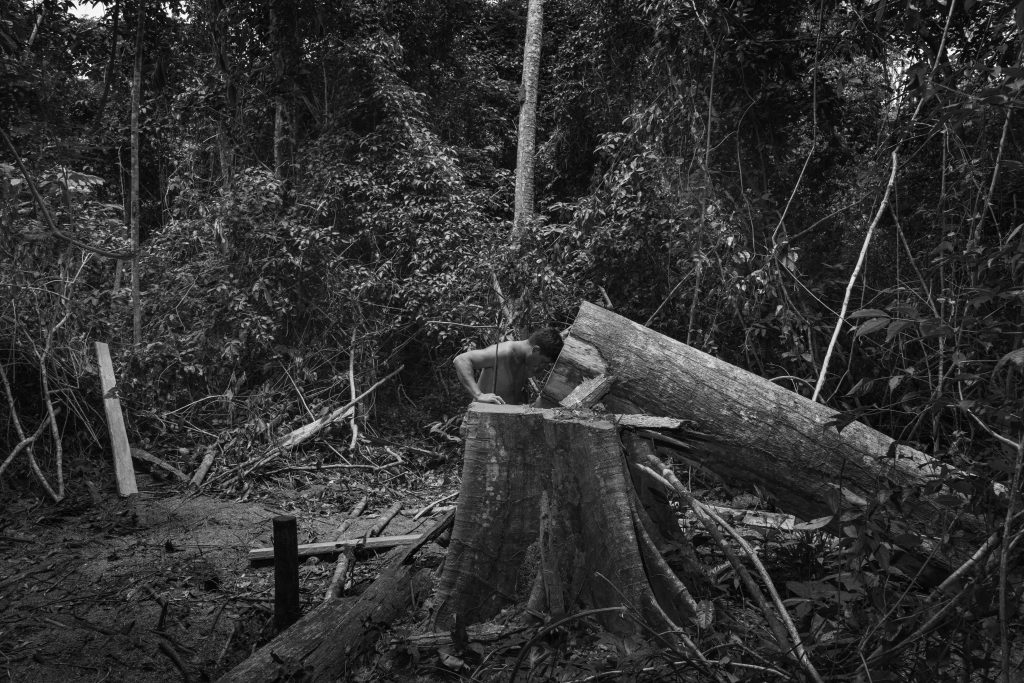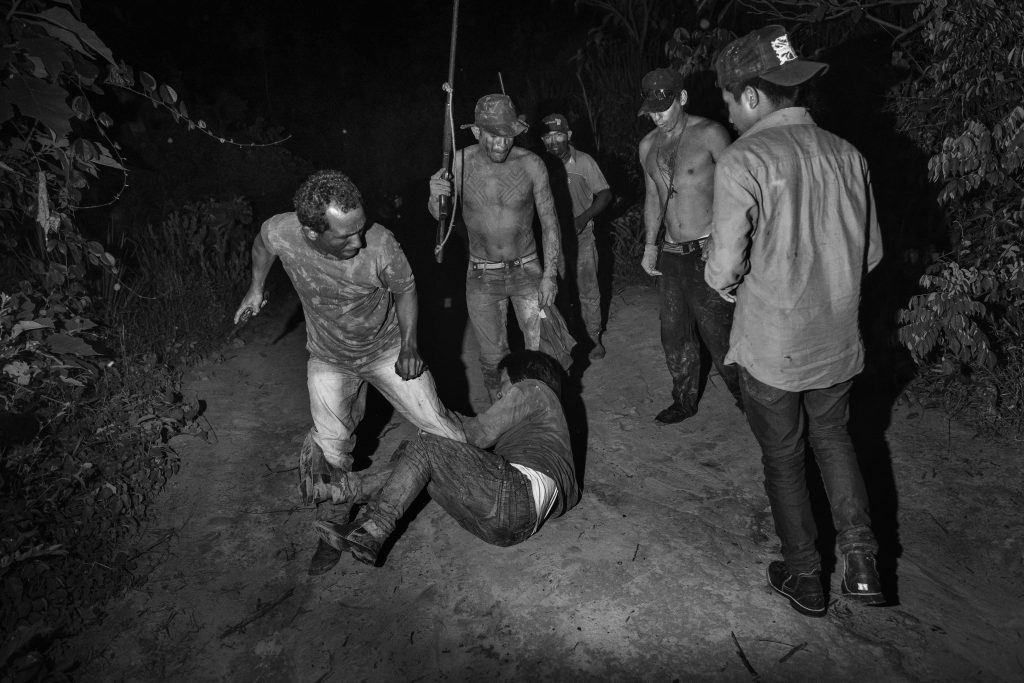by Daniela Mericio
_
The photographs by Tommaso Protti, winner of the tenth edition of the Carmignac Photojournalism Award – which every year finances an investigative photography project on human rights violations and geostrategic issues – lead us to the Brazilian Amazon, in the green lung of the planet, threatened by deforestation, a land torn between environmental emergency and social crises. The images of the reportage, taken between January and July 2019 in the states of Maranhão, Rondônia, Pará and Amazonas, are now on display at the MEP in Paris. The Italian photographer, who now lives and works in San Paolo, talks about it.
It must have been very rewarding to receive that prize. What did these 6 months mean to you?
It was fundamental because it gave me resources and autonomy, but not only that, as the Foundation team supports you with authorizations and research and actually helps to develop the project. I have been working on the Amazon for 5 years, combining “assigned” and self-financing. It is immense, it takes time because of the distances and the complexity of the territory. The grant allowed me to tackle different issues and to develop the project, assembling pieces like in a mosaic.

The Amazon has been at the centre of media attention because of the terrible fires. In your reports you have highlighted how the environmental issues are linked to serious social problems. Can you describe the situation?
The Amazon has always been seen as very stereotyped. We have the idea of a pristine territory, where only jungle and tribes of natives coexist. Over the decades, all the governments of Brazil have encouraged colonization. Over time, people, who were supposed to cultivate but also protect the area, turned into fazenderos, landowners, farmers. Today over 80% of the deforestation in the Amazon is due to intensive meat farming and soy plantations. More than 17% of the forest is lost. From the outside, we only perceive the environmental issue but within the region there is massive exploitation.
What topics did you focus on?
The idea was to create a portrait of modern Amazon, where social and environmental problems overlap. I dealt with various issues, from logging to illegal gold mining, called garimpo, in Brazil. The gold rush develops along two lines: on the one hand there are the multinationals, which buy huge areas of land, on the other, small groups of desperate people, gathered in small towns from where they leave to go hunting for gold in the reserves. They are places where there are only goldsmiths, alcohol and brothels. I also investigated issues such as the agrarian conflict between the peasants, the sem terra (without land) and the large landowners, the fazenderos. Above all, I focused on the uncontrolled growth of large urban centres. Belem, Manaus, Altamira: colonial outposts which have become cities of 2-3 million people due to emigration and in their suburbs there are the largest favelas in Brazil. In addition to poverty, the most serious problem is drugs: the Amazon is one of the main traffic routes and Brazil is the world’s greatest consumer of crack and the second greatest consumer of cocaine. Cities like Manaus or Altamira are devastated by clan wars and they are among the most violent places in the world. I photographed members of criminal organizations, such as the Família do Norte, the most powerful of the Amazon. I wanted to show how deforestation and devastation are also a consequence of increased consumption, being that of meat or cocaine. To save the Amazon we should start from urban centres, creating development models that favour conservation. Pollution, corruption and inequality are all connected factors. My vision is: you can’t save the environment without fighting poverty.

I was impressed by the image of the “Guardians of the forest” in action, is there is a perception of the environmental matter? In what terms?
They are natives of the Guajajara ethnic group, in the state of Maranhão, and for some years have organized themselves into small groups to patrol the reserves threatened by illegal loggers. They call them “the militias”. As long as they do not kill anyone they are tolerated, because they protect their territory. They have become real activists: they go around armed, organize night patrols and, if they catch anyone in the act, they set fire to machinery and camp or seize timber. One night I went with them: the man in the photograph is a native of their same ethnic group, he got beaten up as he was an informant for the lumberjacks and warned them of the ambush. The next day, in an open space in the forest, we found the logs. There I took the very evocative image of the sad native bent over the tree, engrossed in his thoughts. Today loggers cut down trees in one area and quickly move to another – randomly – so that it is more difficult to locate them and monitor the logging. There are no forces to control the territory and impunity is another dramatic factor.
The Amazon has become your “mission”. In the beginning you used to photograph in colour, why then did you switch to black and white?
It is a way of photographing that allows me to express myself better. The first trips were “assigned” and I used colour. Then I realized that the works were interconnected and I felt the need to investigate them in a long-term project; then I started shooting in black and white, because it helped me to combine the various themes in a coherent way; moreover, I felt that I was developing my own language, a recognizable photographic style: black and white, the idea of using flash a lot, of creating tension. An expressive mode that helped me describe the dark side of the Amazon, eliminating the green and bright colours that distracted attention from stories.

In fact, many images are dark, nocturnal …
There are two reasons: the first is that I like the impact of the flash at night; the second is that the region is very hot, so it is difficult to work during the day. Life begins at sunset: when I was with indigenous people, nothing happened in the village during the day, while in the evening a flood of children gathered in the main square to play until late at night.
A report of this kind may present difficulties. How do you organize yourself? Have you found yourself in unpleasant situations?
Distances are immense, so you have to organize travel before you leave. There are no real fixers or stringers, the work has been made easier by the contacts that I have created in recent years. On the ground, reality is unpredictable and often you find your stories when you are there. The difficulties begin when you find yourself in remote places. There are situations in which you feel like you’re in no man’s land and that is a land without laws. As it happened when we wanted to reach a garimpo, an illegal mine, in the state of Pará. It took a couple of days to get to the town of Crepurizão: from there we travelled on a propeller airplane, in which only the pilot had a seat. Our contact was an evangelical pastor who had invited us to photograph the garimpo using as an excuse the carrying out of a service on evangelization. Upon arrival, however, the first outpost was an indigenous village and there were none of their leaders to obtain an authorization from. In reality the problem was that the garimperos were paying the natives to dig in their territory. Furthermore, the pastor had not been clear and the photos had to be made in secret … then, at the village, the chief ordered us to leave, but the airplane had already departed. We were in the middle of nowhere. We made it, but it gets a little difficult to sleep at night, because you find yourself among a thousand illegal activities.

You work in tandem with British journalist Sam Cowie. How important is that?
We are very close. We started working on stories together for the same newspaper. At one point we said that there was something bigger in this region that needed to be told: veiled truth, bloodshed. And we started as a freelance. The photographer sees things, the journalist sees others, and the story gets stronger.
Is photojournalism almost completely entrusted to personal initiative?
I no longer have the romantic vision I had at the beginning, but I believe that photographs can make people aware. I live the profession as a testimony. Photojournalists are an endangered category and for some years I have also done commercial work. You make these projects because you are motivated, you feel the sacred fire of passion.
The future?
A report on the coast of Brazil. And the Amazon: with a colleague I’m also working on a short film, but we would like to develop a full feature movie.
TOMMASO PROTTI | AMAZÔNIA
MEP – Maison Européenne de la Photographie
5/7 Rue de Fourcy – Paris
4 December 2019 – 16 February 2020
Wed and Fri: 11 – 20
Thu: 11 – 22
Sat and Sun: 10 – 20
The bilingual French-English catalogue Amazônia, Life and Death in the Brazilian Rainforest is co-published by Fondation Carmignac and Relief Editions.
All photographs: © Tommaso Protti for Fondation Carmignac
December 4, 2019




